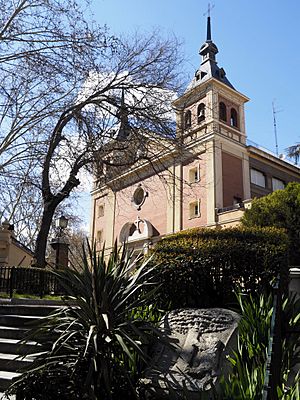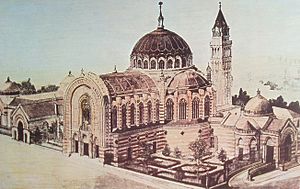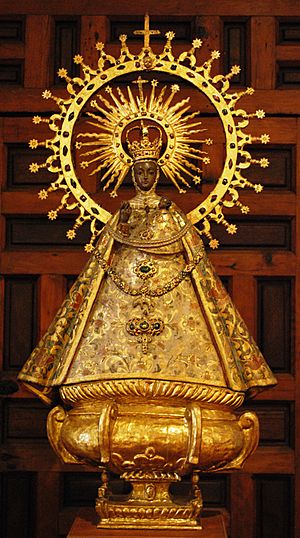Basilica of Nuestra Señora de Atocha facts for kids
Quick facts for kids Royal Basilica of Our Lady of Atocha |
|
|---|---|
|
Real Basílica de Nuestra Señora de Atocha
|
|

Main façade of the basilica
|
|
| Religion | |
| Affiliation | Roman Catholic Church |
| Province | Archdiocese of Madrid |
| Rite | Roman |
| Ecclesiastical or organizational status | Active |
| Patron | Virgin of Atocha |
| Year consecrated | 1150 |
| Status | Basilica |
| Location | |
| Location | Madrid, Spain |
| Architecture | |
| Architectural type | Church |
| Architectural style | Herrerian |
| Groundbreaking | 1150 |
| Completed | 1951 |
| Website | |
| Website of the Basilica | |
The Royal Basilica of Our Lady of Atocha (or Real Basílica de Nuestra Señora de Atocha in Spanish) is a very important church in central Madrid, Spain. You can find it on Avenida de la Ciudad de Barcelona, 1. This historic building is managed by the Dominican order, a group of Catholic priests and brothers.
Contents
History of the Atocha Basilica
The Royal Basilica of Our Lady of Atocha is one of six special churches in Madrid called basilicas. A basilica is a church that has been given special honors by the Pope. It's a bit like a VIP status for churches!
A Long History and a Special Name
The land where the basilica stands has a very long history. The name "Atocha" comes from an old story. It's said that a special statue of the Virgin Mary was found among tall grasses, which were called "tocha" back then. This happened during the Reconquista, a time when Christian kingdoms were taking back land in Spain from Muslim rule.
In 1523, the site was given to the Dominican order by Pope Adrian VI. The Dominicans are a religious group known for their preaching and teaching.
Building and Rebuilding the Church
The original church building became very old and needed to be rebuilt. In the 1890s, a new church was designed by an architect named Fernando Arbós y Tremanti. He designed it in a Neo-Byzantine style, which means it looked like ancient churches from the Byzantine Empire, with domes and arches.
Sadly, this beautiful church was destroyed on July 20, 1936, during the Spanish Civil War. But the people of Madrid were determined to rebuild it. The reconstruction was finished in 1951, bringing the basilica back to life.
The Pantheon of Illustrious Men
Right next to the basilica, you'll find the Pantheon of Illustrious Men (or Panteón de Hombres Ilustres). This is a special place where important Spanish figures are honored. It holds monuments and memorials for many famous people, even though only one former president, José Canalejas y Méndez, is actually buried there. It's a place to remember leaders and thinkers from Spain's past.
See also
 In Spanish: Real basílica de Nuestra Señora de Atocha para niños
In Spanish: Real basílica de Nuestra Señora de Atocha para niños
- Catholic Church in Spain



